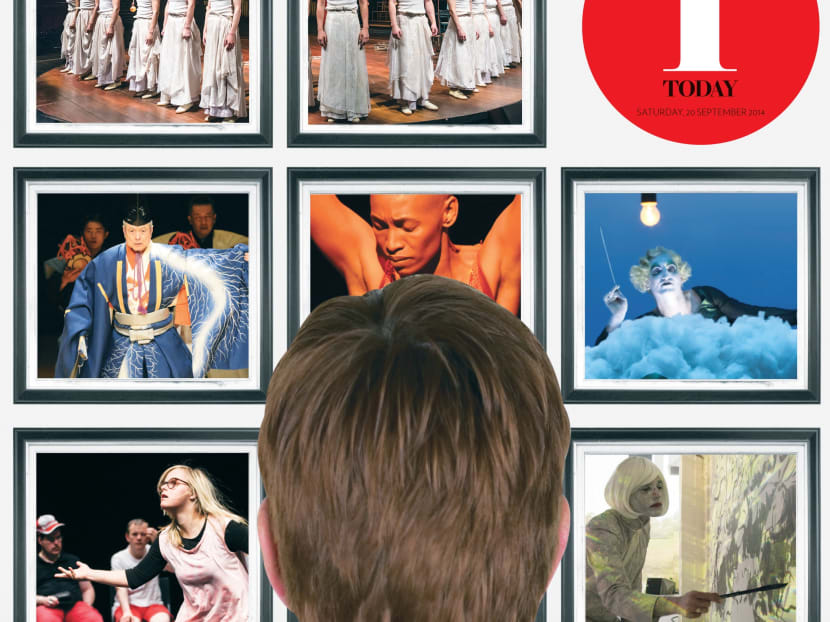9 things we learned at the S’pore Int’l Festival of Arts 2014
After a month and a half, 13 productions and a handful of lectures and mini-presentations, the first edition of the brand new Singapore International Festival Of Arts (SIFA) wraps up tomorrow, with acclaimed theatre company The Wooster Group’s Cry, Trojans! (Troilus & Cressida) and Theater HORA’s collaboration with special needs Singaporeans titled Festival Heart: Into The Wild ending their runs.

Photos: Chong Yew; Kevin Lee; Lucie Jansch; Shivani Gupta courtesy of Nikhil Chopra; Tucky s Photography / artwork: Kenneth Choy; Getty Images
After a month and a half, 13 productions and a handful of lectures and mini-presentations, the first edition of the brand new Singapore International Festival Of Arts (SIFA) wraps up tomorrow, with acclaimed theatre company The Wooster Group’s Cry, Trojans! (Troilus & Cressida) and Theater HORA’s collaboration with special needs Singaporeans titled Festival Heart: Into The Wild ending their runs.
After going on a festival marathon, we’ve come up with a list of things we’ve learnt at SIFA 2014. Read on.
1. IT TICKED ALL THE BOXES OF A FESTIVAL ‘CHECKLIST’ — SORT OF. We’re loath to bring up the idea of a checklist, but we understand why some would like their SIFA to have the components of a “typical” performing arts festival. And if you looked at the line-up, you had it. Opera? Check. Classical music? Check. Musical? Check. Traditional performance? Check. Internationally-renowned names? Check. Of course, everything had a twist. The opera was basically a science lecture. The classical music concerts were atonal and avant garde. The musical was a Tim Burton-esque version of Peter Pan, and at least one famous name was dead and portrayed by a guy in drag (that would be Richard Move literally channelling the late Martha Graham). One element missing in this festival, though, was the presence of Singapore artists. But that was a curatorial decision by festival director Ong Keng Sen, who is set to give a whole bunch of them the spotlight next year.
2. GENRES FLEW OUT OF THE WINDOW. Where do we start? Move’s tribute to dance legend Martha Graham was mostly staged as an interview by two cross-dressing actors. Jerome Bel and Theater HORA’s Disabled Theater was a documentation performance that had some dancing. Some critics, too, were reportedly confused on whether to approach South African dancer Mamela Nyamza’s double-bill show and the Japanese spectacle Sambaso as “theatre” or “dance”. At some point during the London Sinfonietta’s Listen To The 20th Century classical concert series, you were watching a movie. The visual arts, too, said hello: Indian performance artist Nikhil Chopra spent 50 hours painstakingly telling an epic story by painting 72-13’s cavernous space (and you were free to hang out with him throughout the night) while the Belgian production Mystery Magnet was essentially an art lecture and cartoon show gone wild. At SIFA 2014, the performing arts were unshackled.
3. WE MISSED THE ESPLANADE THEATRE. We had rather interesting new fest venues in TheatreWorks’ 72-13 space and the newly revamped Victoria Theatre, but despite the ingenious use of the latter’s stage for the intimate-but-powerful K-musical The Chorus; Oedipus, it’s a small venue that didn’t do justice to the science-opera Facing Goya. Likewise, the Robert Wilson musical Peter Pan could have done with a bigger space than Drama Centre. Both would have been perfect at The Esplanade Theatre, which is unfortunately undergoing renovation until next month. You simply can’t do Singapore’s premier performing arts event and not do big shows at Singapore’s premier performing arts venue.
4. VICTORIA THEATRE AND CONCERT HALL NEEDS ITS F&B. The beautifully revamped VTCH faced its litmus test with SIFA and, despite our misgivings about its smaller audience capacity and space, we would have closed one eye. Our stomachs, though, weren’t happy with the current lack of (decent and fast) dining options around it. While we wait for the F&B outlet(s) to open, can someone install a vending machine?
5. ALL’S WELL THAT ENDS WELL. The spat between festival director Ong and chief executive officer Lee Chor Lin in March threatened to overshadow the event itself. Already under maximum scrutiny after a year-long break, the festival didn’t need a public squabble between its two high-profile and respected bosses. And full credit to Ong and Lee, when it eventually died down, everyone buckled down to their respective tasks and the spotlight fell on SIFA once more. (Leaving those holding the proverbial ringside tickets to further controversy deeply disappointed.)
6. WE CAN’T WAIT FOR NEXT YEAR. That’s because neither can SIFA, which presented a series of teaser performances and talks from Singapore groups for next year’s Post-Empire-themed edition. From experimental musician Margaret Leng Tan’s two wonderful mini-concerts to Kumar’s plans about taking his stand-up material to HDB void decks to a collaboration between two dance giants in Singapore — Goh Lay Kuan and Santha Bhaskar — SIFA 2015 looks very promising.
7. THE OPEN IS AN INTERESTING BUT CONFUSING EXPERIMENT. Giving us a peek into 2015 was all well and good, but coupled with other auxiliary events like the pre-festival The OPEN series in June and July, and the SIFA Shares series of talks (which seems like an extension of The OPEN anyway), it did get confusing. This writer was undecided on whether he suffered from SIFA information overload or experienced two separate festivals. We still think The OPEN should, well, open up to the idea of selling individual tickets to its events since not everyone will be keen to purchase that all-for-one ticket. Also, the absence of post-show discussions at SIFA shows took some getting used to. Collective gushing and bashing had to continue elsewhere (Thank you, WhatsApp group chat).
8. THAT’S ONE LOOOONG FESTIVAL. While previous years packed everything into less than a month, with productions seemingly happening every night in a continuous blur for loyal but exhausted festival marathoners, SIFA 2014 is the equivalent of a holiday by the beach. Spread out over six weeks, it felt rather leisurely and, by the second or third week, it wasn’t so much the festival-as-event that seemed to resonate as much as the shows themselves — from which you had a chance to step back and savour (or recover from).
9. WE NEED TO RETHINK THE IDEA OF SIFA AS A ‘PEOPLE’S FESTIVAL’. There was neither a spectacular opening show nor a rousing closing show, there wasn’t a “festival village” in sight, everything was practically ticketed — and it’s all fine by us. The arts festival has long been dogged by expectations of being a “people’s festival”, but this year’s serendipitous clash of dates with the Singapore Night Festival might put things in perspective. That two-weekend event of spectacles, open-house museums and the odd wrestling match drew half a million people — is it even possible to duplicate the same event and have both happening simultaneously? Or do we need SIFA to offer something else?
If we were to play the numbers game, then SIFA 2014 isn’t likely to impress. Official audience figures are still not out, although as of press time, it only had four completely sold out shows (The Chorus, Oedipus; Sambaso; Peter Pan; and Amid The Clouds). The 30 events at The OPEN drew 8,500 people. Still, you have to ask, too, whether it needs to play that game in the first place.
The Festival has the odd show like Festival Heart: Into The Wild (a result of a workshop with special needs Singaporeans by Theater HORA, which also staged a piece by its own special needs actors) and the young students of the Yong Siew Toh Conservatory ably jammed with the London Sinfonietta for some shows. But surely you don’t expect performance artist Nikhil Chopra to conduct a mass painting session at the Padang?
Whatever “reach-out” or “community” aspect this year’s SIFA had did not feel forced at all. Maybe because it’s now run by an independent company and not the National Arts Council, which would mean that a certain edition’s personality would, in theory, largely be that of its artistic director. And finally, a “people’s festival” does not necessarily equate to a “Singapore” or “Singaporean” festival right? It’s not called Singapore International Festival Of Arts for nothing.
It has been a while since the merging of the Festival of Asian Performing Arts and the Festival of Arts in 1999 gave birth to what has been, until this year, the Singapore Arts Festival. Rebranding it wasn’t merely a cosmetic change but a statement of intent. The history of the festival is rich, but it also has its baggage. The new name is a symbolic break from the past.
For more information on the remaining shows, visit https://sifa.sg. To check out our take on The Wooster Group’s Cry, Trojans! (Troilus & Cressida) and look back at our coverage of the rest of the shows, visit our arts blog For Art’s Sake! (http://tdy.sg/artssakeblog)







